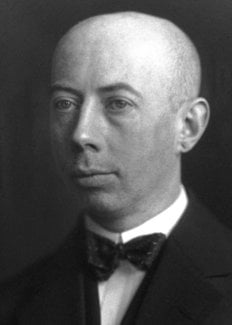Gustav Hertz
Biographical

Gustav Ludwig Hertz was born in Hamburg on July 22nd, 1887, the son of a lawyer, Dr. Gustav Hertz, and his wife Auguste, née Arning. He attended the Johanneum School in Hamburg before commencing his university education at Göttingen in 1906; he subsequently studied at the Universities of Munich and Berlin, graduating in 1911. He was appointed Research Assistant at the Physics Institute of Berlin University in 1913 but, with the onset of World War I, he was mobilized in 1914 and severely wounded in action in 1915. Hertz returned to Berlin as Privatdozent in 1917. From 1920 to 1925 he worked in the physics laboratory of the Philips Incandescent Lamp Factory at Eindhoven.
In 1925, he was elected Resident Professor and Director of the Physics Institute of the University of Halle, and in 1928 he returned to Berlin as Director of the Physics Institute in the Charlottenburg Technological University. Hertz resigned from this post for political reasons in 1935 to return to industry as director of a research laboratory of the Siemens Company. From 1945 tot 1954 he worked as the head of a research laboratory in the Soviet Union, when he was appointed Professor and Director of the Physics Institute at the Karl Marx University in Leipzig. He was made emeritus in 1961, and since then he has lived in retirement, first in Leipzig and later in Berlin.
Hertz’s early researches, for his thesis, involved studies on the infrared absorption of carbon dioxide in relation to pressure and partial pressure. Together with J. Franck he began his studies on electron impact in 1913 and before his mobilization, he spent much patient work on the study and measurement of ionization potentials in various gases. He later demonstrated the quantitative relations between the series of spectral lines and the energy losses of electrons in collision with atoms corresponding to the stationary energy states of the atoms. His results were in perfect agreement with Bohr’s theory of atomic structure, which included the application of Planck’s quantum theory.
On his return to Berlin in 1928, it was his first task to rebuild the Physics Institute and re-establish the School, and he worked tirelessly towards this end. There he was responsible for a method of separating the isotopes of neon by means of a diffusion cascade.
Hertz has published many papers, alone, with Franck, and with Kloppers, on the quantitative exchange of energy between electrons and atoms, and on the measurement of ionization potentials. He also is the author of some papers concerning the separation of isotopes.
Gustav Hertz is Member of the German Academy of Sciences in Berlin, and Corresponding Member of the Göttingen Academy of Sciences; he is also Honorary Member of the Hungarian Academy of Sciences, Member of the Czechoslovakian Academy of Sciences, and Foreign Member of the Academy of Sciences U.S.S.R. He is recipient of the Max Planck Medal of the German Physical Society.
Professor Hertz was married in 1919, with Ellen née Dihlmann, who died in 1941. They had two sons, both physicists: Dr. Hellmuth Hertz, Professor at the Technical College in Lund, and Dr. Johannes Hertz, working at the Institute for Optics and Spectroscopy of the German Academy of Sciences in Berlin.
Since 1943, Professor Hertz is married with Charlotte, née Jollasse.
This autobiography/biography was written at the time of the award and first published in the book series Les Prix Nobel. It was later edited and republished in Nobel Lectures. To cite this document, always state the source as shown above.
Gustav Hertz died on October 30, 1975.
Nobel Prizes and laureates
Six prizes were awarded for achievements that have conferred the greatest benefit to humankind. The 14 laureates' work and discoveries range from quantum tunnelling to promoting democratic rights.
See them all presented here.
